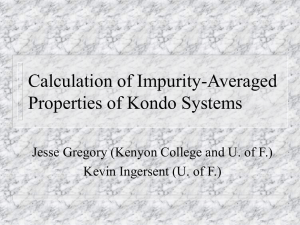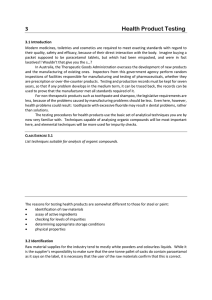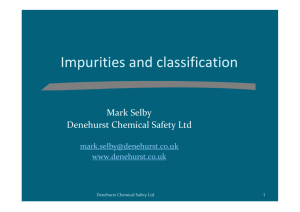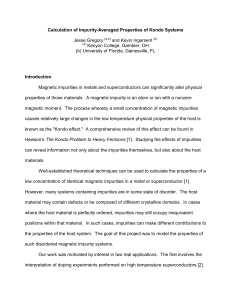Document 13309274
advertisement
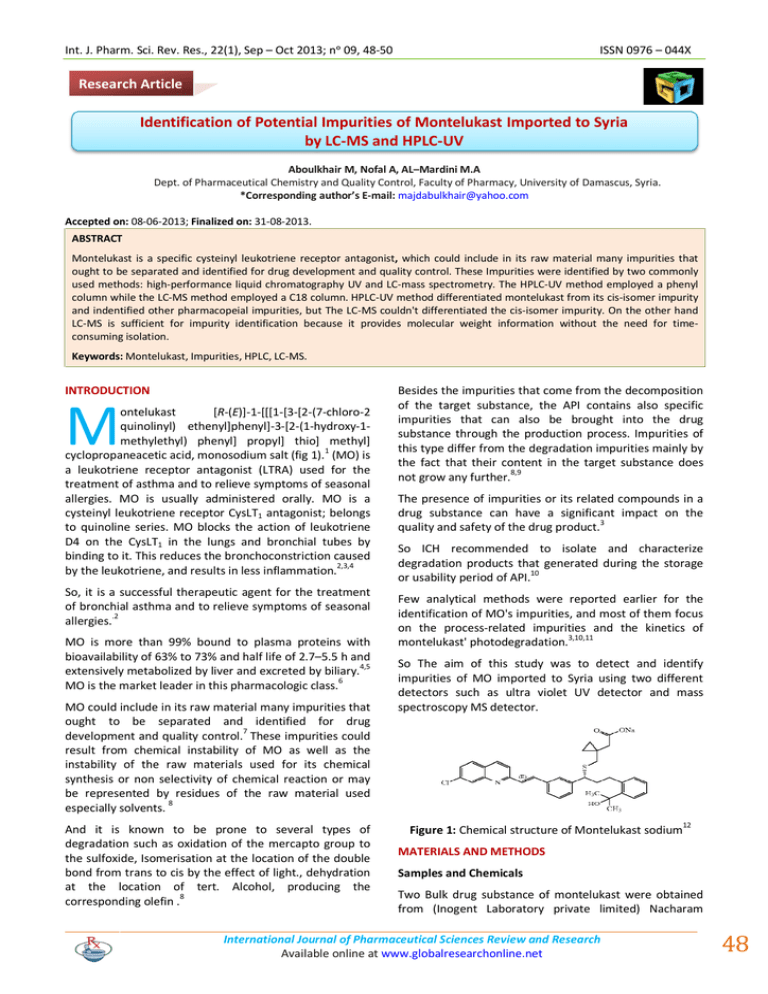
Int. J. Pharm. Sci. Rev. Res., 22(1), Sep – Oct 2013; nᵒ 09, 48-50 ISSN 0976 – 044X Research Article Identification of Potential Impurities of Montelukast Imported to Syria by LC-MS and HPLC-UV Aboulkhair M, Nofal A, AL–Mardini M.A Dept. of Pharmaceutical Chemistry and Quality Control, Faculty of Pharmacy, University of Damascus, Syria. *Corresponding author’s E-mail: majdabulkhair@yahoo.com Accepted on: 08-06-2013; Finalized on: 31-08-2013. ABSTRACT Montelukast is a specific cysteinyl leukotriene receptor antagonist, which could include in its raw material many impurities that ought to be separated and identified for drug development and quality control. These Impurities were identified by two commonly used methods: high-performance liquid chromatography UV and LC-mass spectrometry. The HPLC-UV method employed a phenyl column while the LC-MS method employed a C18 column. HPLC-UV method differentiated montelukast from its cis-isomer impurity and indentified other pharmacopeial impurities, but The LC-MS couldn't differentiated the cis-isomer impurity. On the other hand LC-MS is sufficient for impurity identification because it provides molecular weight information without the need for timeconsuming isolation. Keywords: Montelukast, Impurities, HPLC, LC-MS. INTRODUCTION M ontelukast [R-(E)]-1-[[[1-[3-[2-(7-chloro-2 quinolinyl) ethenyl]phenyl]-3-[2-(1-hydroxy-1methylethyl) phenyl] propyl] thio] methyl] cyclopropaneacetic acid, monosodium salt (fig 1).1 (MO) is a leukotriene receptor antagonist (LTRA) used for the treatment of asthma and to relieve symptoms of seasonal allergies. MO is usually administered orally. MO is a cysteinyl leukotriene receptor CysLT1 antagonist; belongs to quinoline series. MO blocks the action of leukotriene D4 on the CysLT1 in the lungs and bronchial tubes by binding to it. This reduces the bronchoconstriction caused by the leukotriene, and results in less inflammation.2,3,4 So, it is a successful therapeutic agent for the treatment of bronchial asthma and to relieve symptoms of seasonal allergies..2 MO is more than 99% bound to plasma proteins with bioavailability of 63% to 73% and half life of 2.7–5.5 h and extensively metabolized by liver and excreted by biliary.4,5 MO is the market leader in this pharmacologic class.6 MO could include in its raw material many impurities that ought to be separated and identified for drug 7 development and quality control. These impurities could result from chemical instability of MO as well as the instability of the raw materials used for its chemical synthesis or non selectivity of chemical reaction or may be represented by residues of the raw material used especially solvents. 8 And it is known to be prone to several types of degradation such as oxidation of the mercapto group to the sulfoxide, Isomerisation at the location of the double bond from trans to cis by the effect of light., dehydration at the location of tert. Alcohol, producing the corresponding olefin .8 Besides the impurities that come from the decomposition of the target substance, the API contains also specific impurities that can also be brought into the drug substance through the production process. Impurities of this type differ from the degradation impurities mainly by the fact that their content in the target substance does not grow any further.8,9 The presence of impurities or its related compounds in a drug substance can have a significant impact on the quality and safety of the drug product.3 So ICH recommended to isolate and characterize degradation products that generated during the storage or usability period of API.10 Few analytical methods were reported earlier for the identification of MO's impurities, and most of them focus on the process-related impurities and the kinetics of montelukast' photodegradation.3,10,11 So The aim of this study was to detect and identify impurities of MO imported to Syria using two different detectors such as ultra violet UV detector and mass spectroscopy MS detector. Figure 1: Chemical structure of Montelukast sodium12 MATERIALS AND METHODS Samples and Chemicals Two Bulk drug substance of montelukast were obtained from (Inogent Laboratory private limited) Nacharam International Journal of Pharmaceutical Sciences Review and Research Available online at www.globalresearchonline.net 48 Int. J. Pharm. Sci. Rev. Res., 22(1), Sep – Oct 2013; nᵒ 09, 48-50 Hyderabad, India. HPLC grade acetonitrile and methanol were purchased from Panreac Chemicals Corporation Ltd. Spain. Water used for the preparation of mobile phase was purchased from Chem – lab (Belgium). Tri fluoro acetic acid TFA was purchased from Sigma-Aldrich (USA) and ortho phosphoric acid was obtained from BDH Laboratory Supplies (Poole, UK). High Performance Liquid Chromatography (HPLC) With MS Detector ISSN 0976 – 044X RESULTS AND DISCUSSION Results MO impurities (related to synthesis as well as degradation processes) were identified using LC-MS and HPLC-UV. Bulk drug substances of MO were analyzed by LC-MS using scan mode from 100-800 mu to produce spectra of molecular weight due to different types of impurities, reported in tables (1) and (2). Table 1: Impurities of MO by MS in sample (1) An Agilent HPLC system and an Eclipse XD8 C18 column (250×4.6 mm, 5 µm particle size) was used as stationary phase. A mobile phase consisting of solution A 0.1% ortho phosphoric & solution B: 80 % acetonitrile + 20 % water, with a time gradient program of T (min)/%B (v/v). Initial gradient of B starts with 60%, at 10 min it is 70%, at 15 min it is 90%. The ratio being increased to 100% at 20 min then decrease to 60 %at 32 min, and maintained 60% until 45 min with a flow rate of 0.4ml/min. The electrospray ionization and MS studies were performed on a triple quadruple mass spectrometer PE Sciex model API 3000. Compound The instrument parameters used are: Sulfoxide impurity 602 Capillary : 2000 V Methylketone impurity 570 Extractor : 2500v Methylstyrene impurity 568 Source temperature : 350 C Dihydro impurity 588 Gas flow : 10 L/min Michael Adducts 1c and 2d 732 Scan range : 100-800 mu Unknown impurity 772 Injection volume : 20 µl High Performance Liquid Chromatography (HPLC) With UV Detector A Hitachi HPLC system containing a L 2130 pump plus degasser, L 2200 auto-sampler, L 2420 UV/VIS Detector. A SHIMADZU L11 column (150×4.6 mm, 5 µm particle size) was used as stationary phase. A mobile phase consisting of solution A: 0.15% trifluoroacetic acid (TFA) in water & solution B: 0.15% TFA in acetonitrile in ratio of 40% of solution B from 0 – 3 min in isocratic elution to increase to 58.6% at 25 min in a liner gradient. The mobile phase was pumped at a flow rate of 1.2 ml / min 13 the eluents were monitored at 238 nm. Sample Preparation for HPLC-UV About 50 mg of bulk MO was weighed accurately and transferred to 50 ml volumetric flask. The volume was made up to mark with the diluent (Methanol and water 9:1) to obtain a concentration of 1mg/ml. Sample Preparation for LC-MS About 50 mg of bulk MO was weighed accurately and transferred to 50 ml volumetric flask. The volume was made up to mark with the diluent (acetonitrile and water 8:2) to obtain a concentration of 1mg/ml. Compound Molecular weight Sulfoxide impurity 602 methylketone impurity 570 Methylstyrene impurity 568 Dihydro impurity 588 Table 2: Impurities of MO by MS in sample (2) Molecular weight The same bulk drug substances of MO were analyzed by HPLC-UV to produce chromatograms of MO with different types of impurities, reported in tables (3) and (4). Table 3: Impurities of MO by UV in sample (1) Compound RT RRT Sulfoxide impurity 5.55 0.5 Cis-isomer impurity 9.51 0.88 Methylketone impurity 11.65 1.1 Un known impurity1 13.71 1.27 Un known impurity2 17.25 1.6 Table 4: Impurities of MO by UV in sample (2) Compound RT RRT Sulfoxide impurity 5.33 0.5 Cis-isomer impurity 9.20 0.88 Un known impurity1 17.05 1.63 Un known impurity2 17.57 1.67 A typical chromatogram showing the MO separated from its related impurities of the drug is given in Fig.2. International Journal of Pharmaceutical Sciences Review and Research Available online at www.globalresearchonline.net 49 Int. J. Pharm. Sci. Rev. Res., 22(1), Sep – Oct 2013; nᵒ 09, 48-50 ISSN 0976 – 044X Montelukast in Human Plasma by HPLC Coupled with ESIMS/MS: Application to a Bioequivalence Study, Scientia pharmaceutica, 30, 2010, 411–422. 3. M. Saravanan, K. Siva kumari, P. Pratap Reddy, Identification, synthesis, isolation and spectral characterization of potential impurities of montelukast sodium, Journal of Pharmaceutical and Biomedical Analysis, 48, 2008, 708–715. 4. Terrence W Carver, Jr., Exercise-induced asthma: critical analysis of the protective role of montelukast, Dovepress journal of asthma and allergy, 2009, 93–103. 5. Jaime A., Lagos and Gailen D. Marshall, Montelukast in the management of allergic rhinitis, Dovepress Therapeutics and clinical Risk Mangement, 2007, 327–332. 6. Finkel R, Clark Michelle A. Lippincott's Illustrated Reviews: Pharmacology. Lippincott Williams & Wilkins, fourth Edition, 2009. More MO impurities were detected and identified by using MS detector, on the other hand less impurities were detected and identified by using UV detector. 7. F.J. Rupe´rez, H. Ferna´ndez, C. Barbas, LC determination of loratadine and related impurities, Journal of Pharmaceutical and Biomedical Analysis, 29, 2002, 35–41. Identification of impurities in MS was done by using molecular weight, while in UV it was done by using relative retention time RRT. 8. Helma et al. Patent Application Publication, Pub No.: US 2011/0034692 A1, Pub Date: Feb.10, 2011. 9. Kavita Pilaniya, Harish K. Chandrawanshi, Recent trends in the impurity profile of pharmaceuticals, J Adv Pharm Technol Res, 2010, 302–310. 10. ICH Harmonised Tripartite Guidelines, Impurities in New Drug Substances Q3A(R1), International Conference on Harmonisation of Technical Requirements for Registration of Pharmaceuticals for human use, October 2006. 11. Ibrahim A. Alsarra , Development of a stability-indicating HPLC method for the determination of Montelukast in tablets and human plasma and it's applicatiom to pharmacokinetic and stability studies, Saudi Pharmaceutical Journal, 12(4), 2004, 137- 143. CONCLUSION 12. The use of LC-MS is sufficient for impurity identification and is a common approach within the early stages of pharmaceutical development but isn't sufficient in the case of drugs which have isomers impurities such as MO with cis-isomer impurity. We should integrate data from two detectors (MS, UV) to possess full information for identification of MO impurities. J. Roman, R. Breier, M. Steppe, Stability Indicating LC Method to Determination of Sodium Montelukast in Pharmaceutical Dosage Form and its Photodegradation Kinetics, Journal of Chromatographic Science, 49, 2011, 540 – 546. 13. http:// drug bank.ca 14. E. Gonikberg, M. Waddell, Pharmacopeial Forum Vol. 37(2), 2010. The United States Pharmacopeial Convention. 15. Al Omari MM, Zoubi RM, Hasan EI, Effect of light and heat on the stability of montelukast in solution and in its solid state, J Pharm Biomed Anal, 45(3), 2007, 465-71. Figure 2: Typical chromatogram of MO and its impurities in sample (1) DISCUSSION Michael Adducts 1c and 2d impurities were detected by MS only, because it is very hard to be resolve them from MO peak. A major degradation product "cis-isomer impurity" which rises very fast by exposure to ambient light affecting substance quality14, was identified by UV only, because cis-isomer impurity has the same molecular weight as MO that make identifying it by MS detector not possible, while it is separated using the HPLC-UV method with a RRT of 0.88 REFERENCES 1. http://dailymed. nlm.nih.gov 2. Balasekhara Reddy Challa, Bahlul Z. Awen, Babu Rao Chandu, Method Development and Validation of Source of Support: Nil, Conflict of Interest: None. International Journal of Pharmaceutical Sciences Review and Research Available online at www.globalresearchonline.net 50
